Related Research Articles

The Canadian Coast Guard is the coast guard of Canada. Formed in 1962, the coast guard is tasked with marine search and rescue (SAR), communication, navigation, and transportation issues in Canadian waters, such as navigation aids and icebreaking, marine pollution response, and support for other Canadian government initiatives. The Coast Guard operates 119 vessels of varying sizes and 23 helicopters, along with a variety of smaller craft. The CCG is headquartered in Ottawa, Ontario, and is a special operating agency within Fisheries and Oceans Canada.
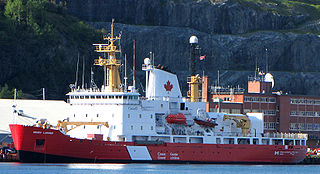
CCGS Henry Larsen is a Canadian Coast Guard Improved Pierre Radisson-class icebreaker serving in the Newfoundland and Labrador region and based in St John's, Newfoundland and Labrador. Entering service in 1988, Henry Larsen is the fourth ship and of an improved design over the rest of the ships in her class. The ship operates in the Arctic Ocean during summer months.

CCGS Amundsen is a Pierre Radisson-class icebreaker and Arctic research vessel operated by the Canadian Coast Guard. The vessel entered service in 1979 as Franklin and was renamed Sir John Franklin in 1980 and served as such until 1996. Declared surplus, the vessel was used as an accommodation ship in Labrador in 1996 and placed in reserve in 2000. In 2003, the ship was reactivated and underwent conversion to an Arctic research vessel. The ship recommissioned as Amundsen.

CCGS Louis S. St-Laurent is a Canadian Coast Guard (CCG) heavy icebreaker. Louis S. St-Laurent's home port is St. John's, Newfoundland and Labrador. She is the largest icebreaker and flagship of the CCG.

CCGS Leonard J. Cowley is an ice-strengthened fisheries patrol vessel of the Canadian Coast Guard. The ship entered service in 1984 and is still currently in service. During the Turbot War, the patrol vessel took part in the detainment of the Spanish fishing vessel Estai. Leonard J. Cowley's home port is St. John's, Newfoundland and Labrador.

CCGS John P. Tully is an offshore oceanographic science vessel in the Canadian Coast Guard operating out of Pacific Region at CGS Base Patricia Bay in Sidney, British Columbia. Prior to 1995, the ship was assigned to Fisheries and Oceans Canada. The vessel entered service in June 1985 with the Department of Fisheries and Oceans on the West Coast of Canada. In 1995, the fleets of Fisheries and Oceans and the Canadian Coast Guard were merged under Canadian Coast Guard command and John P. Tully became a Coast Guard vessel.
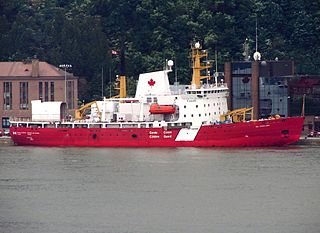
CCGS Des Groseilliers is a Pierre Radisson-class icebreaker in the Canadian Coast Guard. The vessel is named after Médard Chouart des Groseilliers (1618–1669) a close associate of Pierre-Esprit Radisson in explorations west of the Great Lakes and the founding of the British Hudson's Bay Company. The ship entered service in 1982. The vessel has participated in a number of research voyages, including Ice Station SHEBA. As part of the Surface Heat Budget of the Arctic Ocean experiment conducted in the Arctic Ocean from October 1997 to October 1998 to provide polar input to global climate models, Des Groseilliers was allowed to be frozen into the ice for the Arctic winter, to serve as a base for scientific researchers.
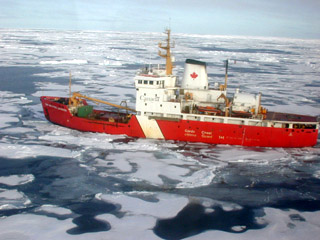
CCGS Sir Wilfrid Laurier is a Martha L. Black-class light icebreaker and major navaids tender of the Canadian Coast Guard. Built in 1986 by Canadian Shipbuilding at Collingwood, Ontario, Canada, she was the last ship constructed there. The ship has been based out of Victoria, British Columbia.
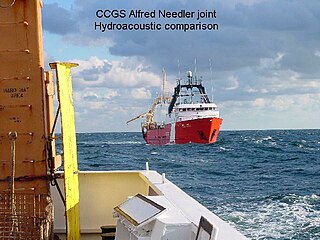
CCGS Alfred Needler was an offshore fishery science vessel operated by the Canadian Coast Guard. The vessel entered service in 1982 with the Department of Fisheries and Oceans, stationed at the Bedford Institute of Oceanography in Dartmouth, Nova Scotia. In 1995, in order to reduce the number of ships and combine tasks, the Fisheries and Oceans fleet and the Canadian Coast Guard fleets were merged under the Canadian Coast Guard.

CCGS W.E. Ricker was a Canadian Coast Guard offshore fisheries research vessel. The ship was originally constructed as the commercial fishing trawler Callistratus, but was purchased by the Government of Canada in 1984 and converted to a fisheries research vessel and renamed W.E. Ricker. The vessel entered service with the Department of Fisheries and Oceans in 1986 and was transferred to the Canadian Coast Guard in 1995 after the two fleets were amalgamated. The ship was assigned to the West Coast of Canada and was decommissioned on 14 March 2017.
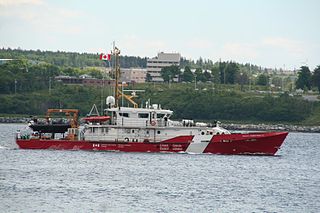
The Hero-class patrol vessels, previously the Mid-Shore Patrol Vessel Project, is a series of nine patrol vessels constructed by Halifax Shipyards for the Canadian Coast Guard. Based on the Dutch Damen Stan 4207 patrol vessel, construction began in 2011 and the first vessel entered service in 2012. The vessels are assigned to the Atlantic and Pacific coasts of Canada, used for coastal patrol duties.
CCGS Wilfred Templeman was a Canadian Coast Guard fisheries research vessel that entered service 1981 with the Department of Fisheries and Oceans. In 1995 the Fisheries and Oceans and Canadian Coast Guard fleets were amalgamated and Wilfred Templeman joined the Canadian Coast Guard. The research vessel patrolled the coast off Newfoundland and Labrador. In 2011, the vessel was taken out of service, sold to commercial interests and renamed Blain M.
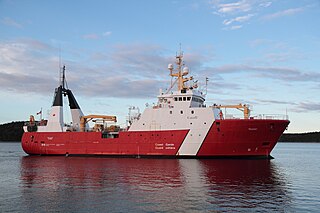
CCGS Teleost is a Canadian Coast Guard fisheries research vessel. The ship was originally constructed in Norway in 1988 as a commercial fishing trawler named Atlantic Champion. In 1993, the Canadian government purchased the vessel and after a competition among schoolchildren, the vessel was named Teleost by the winner. The vessel was converted to an offshore fisheries research vessel in 1994–1995 and entered service in 1996 with the Canadian Coast Guard. The ship is currently in active service.
CCGS Sir John Franklin is an offshore fisheries research ship of the Canadian Coast Guard. The ship was ordered in 2011 as part of the Canadian National Shipbuilding Procurement Strategy (NSPS) as a replacement for aging Canadian Coast Guard vessels. The ship was launched on 8 December 2017, named for Sir John Franklin, an arctic explorer who led two Royal Navy expeditions in search of the Northwest Passage, the second ending with the death of all his crew around 1848. The first of three vessels, Sir John Franklin is the sister ship of CCGS Capt. Jacques Cartier and CCGS John Cabot.

The Pierre Radisson-class icebreakers, also known as R-class icebreakers, are a class of four icebreakers constructed for and operated by the Canadian Coast Guard. The Canadian Coast Guard designates the four ships in the class as medium icebreakers. Built in two phases, the first three ships, Pierre Radisson, Franklin and Des Groseilliers, were built to a common design. The fourth, Henry Larsen was built to a modified design and is considered a subclass, the Improved R-class icebreaker. Franklin was later renamed Sir John Franklin before undergoing a re-design for use primarily as an Arctic research vessel. Upon the vessel's return to service, the ship was once again renamed Amundsen. All the vessels are named for people who sailed through Canada's northern waters. The class operates in the Arctic Ocean in the summer, patrolling, icebreaking and research missions.
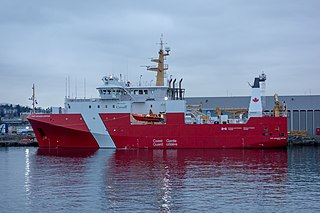
CCGS Capt. Jacques Cartier is an offshore fisheries research ship of the Canadian Coast Guard. The ship was ordered in 2011 as part of the Canadian National Shipbuilding Procurement Strategy (NSPS) as a replacement for aging Canadian Coast Guard vessels. Capt. Jacques Cartier is the sister ship of CCGS Sir John Franklin and CCGS John Cabot. The ship was constructed at Seaspan Shipyard, Vancouver, British Columbia and launched on 5 June 2019.
CCGS John Cabot is the name of two ships of the Canadian Coast Guard, honouring the Italian explorer John Cabot.
John Cabot is a shipname. Several ships have held this name:
Sir John Franklin (1786–1847) was a British naval officer and Arctic explorer, whose last expedition to the Arctic was famously lost.
References
- 1 2 Department of Fisheries and Oceans. "CCG Fleet: Vessel Details - CCGS Sir John Franklin". Government of Canada.
- ↑ Department of Fisheries and Oceans. "CCG Fleet: Vessel Details - CCGS Amundsen". Government of Canada.